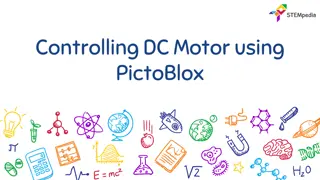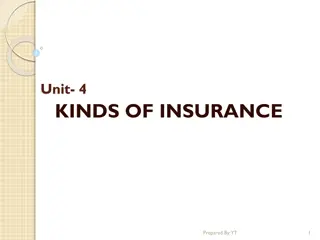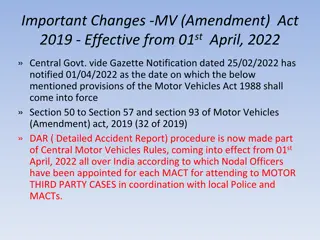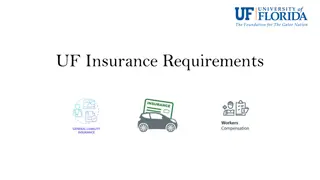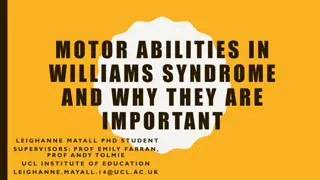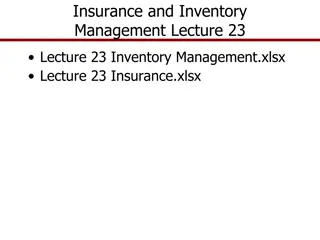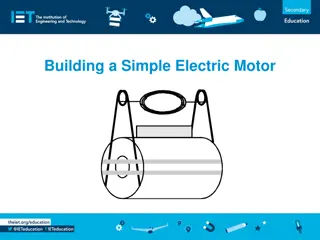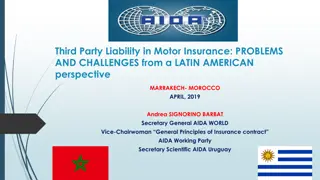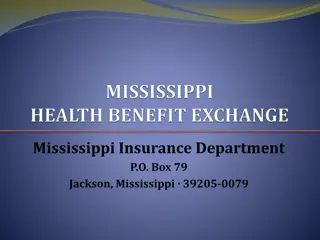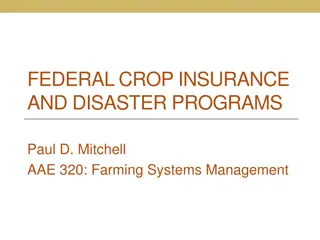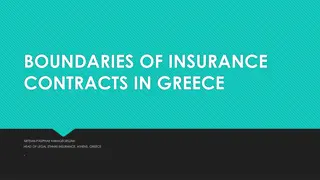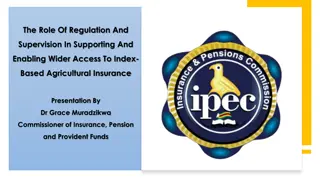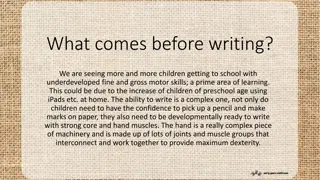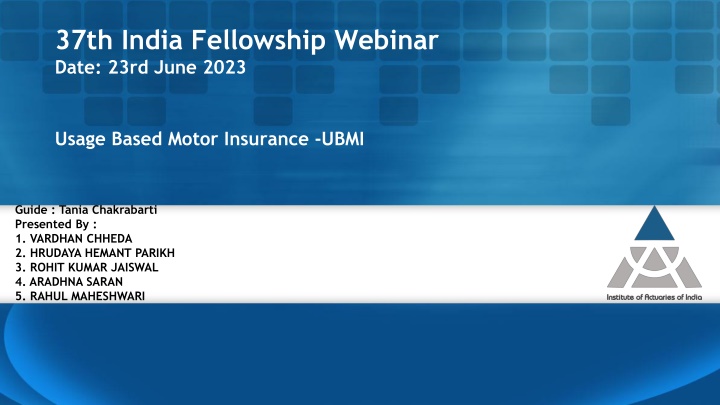
Insights into Usage-Based Insurance (UBI) and Its Global Impact
Explore the world of Usage-Based Insurance (UBI) through this webinar guide featuring Tania Chakrabarti. Learn about UBI, its technology aspects, global market insights, and key players like UnipolSai and Progressive. Discover how UBI is revolutionizing the insurance industry with pay-as-you-drive, pay-how-you-drive, and manage-how-you-drive models. Stay informed about the dominance of North America in the UBI market, anticipated growth in Asia Pacific, and regulatory developments in Europe.
Download Presentation

Please find below an Image/Link to download the presentation.
The content on the website is provided AS IS for your information and personal use only. It may not be sold, licensed, or shared on other websites without obtaining consent from the author. If you encounter any issues during the download, it is possible that the publisher has removed the file from their server.
You are allowed to download the files provided on this website for personal or commercial use, subject to the condition that they are used lawfully. All files are the property of their respective owners.
The content on the website is provided AS IS for your information and personal use only. It may not be sold, licensed, or shared on other websites without obtaining consent from the author.
E N D
Presentation Transcript
37th India Fellowship Webinar Date: 23rd June 2023 Usage Based Motor Insurance -UBMI Guide : Tania Chakrabarti Presented By : 1. VARDHAN CHHEDA 2. HRUDAYA HEMANT PARIKH 3. ROHIT KUMAR JAISWAL 4. ARADHNA SARAN 5. RAHUL MAHESHWARI
Guides Introduction Tania Chakrabarti is a FIAI, FCAS, MSQE She has nearly two decades of experience in general insurance (Actuarial) Worked across various GI Companies (Chola MS, Royal Sundaram, Bharti AXA) Worked in Consulting in EY Served as a Panel Actuary working on annual actuarial valuation for Agricultural Insurance Company Currently she is Appointed Actuary of Edelweiss General Insurance Served on various committee for IRDAI and IAI www.actuariesindia.org
What is Usage Based Insurance (UBI)? Type of insurance where the payable premium for the policy is directly linked with the usage of the insured product / service. In the auto insurance industry, it is also commonly known as Telematics insurance. Telematics is useful to track, store and transfer driving related data to the insurer and this data comes in handy to understand the driving behaviour and charge appropriate vehicle insurance rates. The following types of UBI are available for auto insurance: Pay as you drive (PAYD) Pay how you drive (PHYD) Manage how you drive (MHYD) www.actuariesindia.org
Technology under UBI Based on technology, UBI is segmented under the following types: Smartphones Embedded Systems Black Box Other Technologies In terms of revenue, the embedded system dominated the UBI global market with a revenue share of 50.16% in 2019. The smartphone segment is projected to witness substantial growth over the next few years with recent CAGR observed at around 27%. www.actuariesindia.org
UBI Global Insights North America dominated the market as of 2020 with a valuation of ~12 billion USD. Asia Pacific is anticipated to exhibit a higher CAGR over the next few years led by increased mobile connectivity and smartphone technology. Europe has been growing significantly due to increased regulatory support in relation to vehicle telematics. In 2017, Italy implemented a law that requires insurance carriers to install telematics devices in all automobiles and set premiums based on real time data obtained. Similarly, the eCall system and ERA-GLONASS are mandatory for passenger cars and freight vehicles across the European Union and Russia. The UBI market is led by globally established players such as UnipolSai Assicurazioni S.p.A, Progressive Casualty Insurance Company, Allstate Insurance Company, Liberty Mutual Insurance Company, etc. The global insurance market is dominated by PAYD followed by PHYD and MHYD. MHYD is expected to be the fastest growing market aided by the evolution of data analytics technology. www.actuariesindia.org
UBI Indian Context UBI is currently being sold in India under the IRDAI regulatory sandbox. PAYD is most common type of UBI product sold currently. The policy tenure is for one year IRDAI decides the third party premium to be charged and thus the own damage premium is decided by UBI Own damage premium depends on the car usage slab as per the kilometres covered. Once the distance balance has been exhausted, one needs to get it recharged by contacting the insurance provider. Many major insurers in the market such as Bajaj Allianz, TATA AIG, ICICI Lombard, Go Digit and Acko have received approval under the regulatory sandbox to offer UBI for auto insurance. www.actuariesindia.org
UBMI pricing and how it differs from traditional motor insurance pricing In India, the Motor Third Party insurance premiums are mandatory by law and regulated by IRDAI. Thus, third party premium remains same under both Traditional and Usage based motor insurance products. Though coverage under motor own damage section remains same, pricing differs for each type as follows: Considerations Traditional Motor insurance pricing Usage based motor insurance pricing Policy tenure Time based (Annual) Distance based (policy active for defined kilometres slab opted) Exposure measure No. of vehicles insured/ Policy count (For ease of computation) Kilometres driven (Ideal measure as directly proportional to risk) Rating factors used in pricing Rating factors as per Indian Motor tariff- IDV, Cubic Capacity, Geographical Zones, Vehicle Age. Other proxies of underlying risk factors used as rating factors include: Type of cover, Deductible opted Age of vehicle Make and Model of vehicle Use of vehicle Where is vehicle parked overnight Age, gender and occupation of policyholder Address/Location of policyholder NCB level Additionally, Risk factors which have bearing on amount of risk can be directly used in rating: Distance driven Driving skills Speed at which vehicle is driven Density of traffic Route on which vehicle driven Time of the day when driven Theft risk Fire risk www.actuariesindia.org
UBMI pricing and how it differs from traditional motor insurance pricing Considerations Traditional Motor insurance pricing Usage based motor insurance pricing Nature of Premium Fixed cost, assessed annually. Paid for in lump sums on an annual, semi-annual, or quarterly basis. Generalised pricing- relying on aggregated statistics and driving records that are based on past trends and events Fixed component (for risks not directly affected by mileage like fire and theft risk) + Variable cost (based on distance driven for own damage cover) Customised/individualized and precise- depends on car owner s risk profile based on the distance covered, the average speed of the vehicle, frequency of using the vehicle, and the overall driving skills. Telematics device/ beacon/ mobile application that tracks and notes where, when, and how the vehicle was driven? What was its speed? Does the driver follow the speed limit throughout the year? Premium based on distance travelled and driving skills. A driver who drives long distance at high speed will be charged a higher rate than a driver who drives short distances at slower speeds. Pricing approach Collection of rating factor information Mainly through proposal forms filled by policyholders providing vehicle, personal and cover related details Usage and driving skills Premiums are calculated irrespective of how much and how the car is driven. Premium based on past experience of claims in portfolio Changes in portfolio mix: Mix skewed towards policyholders with good driving skills and infrequent vehicle usage. Also, the proportion of young and tech savvy policyholders from urban and metro cities would increase in portfolio. www.actuariesindia.org
UBMI pricing- Risk premium considerations Impact on frequency: Good drivers with infrequent usage- Lower claims frequency Telematics technology- improve response time and monitor driver safety- Reduce claim frequency Lower driving speed- Reduce total loss/CTL claims frequency Vehicle trackable using GPS technology- stolen vehicles can be tracked and recovered- Lower theft claims frequency Impact on severity: Better driving skills- Large injury claims and death claims reduced Speeds involved in accident are lower- Lower claim severity Telematics technology- more accurate estimate of accident damages and reduce fraud- by analyzing the driving data (such as hard braking, speed, and time) during an accident. www.actuariesindia.org
UBMI pricing- Office premium considerations Expenses: Implementation of a UBI program with telematics technology- costly and resource intensive for insurer IT system upgradation costs Initial fixed set up cost- high, variable cost related to policy issuance- lower Lower claim handling costs- inspection can be done on real time based on data provided by telematics system Commissions: Preferred by tech savvy customers- majority of policies sold through online channel- lower commission related costs. RI Costs: Changes in RI requirements- Cyber insurance cover- sensitive data collected Renegotiations of existing cover with Quota share reinsurers Investment income: Policyholders with good driving skills and infrequent usage opting for UBMI policy- lower Average ticket size- lower investment income. www.actuariesindia.org
UBMI modelling and analysis The current UBMI loss cost prediction models are broadly of two types: Type 1: Based on total mileage, time of day and no. of breaking, speeding and cornering events. Better than conventional pricing models. But still secondary contributors to risk- add limited predictive ability Limited data collection- easier analysis of data Lower privacy concerns to policyholders Type 2: Collecting more granular data on vehicle use on second-by-second basis for each trip and analyzing it on contextual basis Analyzing event in context of environment like road type, weather conditions, speed limits Usage of external data- Road classification based on accident rates, Road accident statistics, Motor vehicle theft and recovery records Increases predictive power of model Data Privacy concerns Ability to identify risky driving behavior and provide training to drivers to reduce accidents. www.actuariesindia.org
UBMI pricing models Annual pricing Hybrid model (Exposure- No. of Vehicles) Telematics pricing model Traditional pricing model Telematics rating factors Traditional rating factors Hybrid model (Exposure- Kms driven) Distance based pricing Pricing models- Generalised linear models (GLMs) or other advanced machine learning models like Decision trees can be used to build optimal pricing model www.actuariesindia.org
UBMI pricing- Other pricing challenges Cost of telematics box- increases premiums for policyholders- Mitigation- mobile-based telematics- no need to install a device in a car; a mobile application will suffice. Pricing each policy individually breaks the pooling of risk principle of insurance- good risks no longer subsidize bad risks. Thus, leading to affordability issues for high-risk drivers. Mileage not known at start of policy- opt for lower mileage plan and then top up kms once base plan is exhausted Driver skills difficult to quantify- Driving skill during policy period or retrospective assessment? Multiple drivers? Difficulty in analysing big data (collected on second-by-second basis for each trip for each policyholder) Uncertainty surrounding the selection and interpretation of driving data and how that data should be integrated into existing or new price structures to maintain profitability. Transitioning of lower-risk drivers into UBI programs- lower premiums- can put pressure on overall insurer profitability. Correlation of new UBMI rating factors with existing rating factors in pricing model Pricing uncertainty- New offering- Past experience not available Privacy concerns of policyholders related to telematics data www.actuariesindia.org
Impact of Covid 19 on traditional auto insurance purchase There was a 31% drop in motor vehicle sales in FY 2020-21 as compared to FY 2019-20 as per the Federation of automobile dealers associations ( FADA) report*. There was a 14.04% growth in FY 2019-20 for motor own damage premium which dropped to 13.11% in FY 2020-21*. Whereas third party liability component dropped from 22.46% growth to 21 % in FY 2020-21*. Policy renewals were a major contribution to growth rather than newly issued motor policies Traditional and large insurance companies were reluctant to incorporate technological innovations. Products were being sold mainly through the major channels such as the insurance agents and motor dealers These channels sell the insurance policies to individual clients through personal visits, call centers In the time of covid 19 owing to travel restrictions and lockdown they were unable to operate call centers and visit clients Hence selling motor insurance through offline mode became more difficult during covid 19 This results in a decrease in renewal as well as new business premium All insurers invest a large proportion of their budget in developing IT systems to maintain market share through online selling of motor insurance business that does not require the physical presence No paperwork or physical presence for buying, renewing policies, or claim settlements are required One can easily buy an insurance policy just by visiting the insurance companies websites or through the mobile app. This new selling channel has considerably reduced the cost of insurance as there is no commission paid to agents * Articles published by Acko insurance on June 3, 2022 www.actuariesindia.org
Key drivers towards Usage based motor Insurance COVID-19 had severely impacted the economy with business shutdowns and job losses. Due to strict lockdown restrictions and telecommuting options, most vehicles have been off-road. Owing to job loss or salary cutmore and more customers were rationing their expenses, and one of the options being explored was to reduce their auto insurance premium now when their vehicle is mostly confined to their garage and return to complete commute is not yet certain. Also, one of the major impacts of Covid-19 is in the advent of new working culture, where most of the employees of the companies were working from home. Many organizations have come up with hybrid model where the employees have been given options to come to office for some days and work from home for rest of the days of the week. In addition to this, we are witnessing a rise in usage of rideshare services like Ola and Uber for general commute, and therefore, personal vehicles are not always getting driven on a regular basis. Owing to the sudden behavioral changes in the society due to Covid-19 pandemic, customers are challenging the concept of giving flat rates for their auto insurance and rather have the Insurer personalize the rate based on their driving parameters For those who are driving regularly, from a behavioral aspect, are expecting some sort of reward or discount for safe driving, zero traffic violation, or zero accidents. Flat rate insurance does a disservice to drivers who are driving less mileage and safely. www.actuariesindia.org
The Advantage UBMI for customers Insurance risk assessment: Insurance companies can use telematics to monitor drivers behavior, evaluate their risk levels and set insurance premiums. The primary reason that most individuals or companies try usage-based insurance is for the associated discounts. Reduce accidents: Receive speeding reports and use this information to improve driver performance and road safety for your fleet of vehicles Accident Investigations: If the insured vehicle is involved in an accident, it is much easier to do forensics when there is GPS data leading up to the incident. The authorities and insurance claims adjusters can use telematics information, such as the braking intensity, speed, and acceleration, to pinpoint what went wrong and settle the claim more accurately. www.actuariesindia.org
The Advantage UBMI for customers Safety tracking: Telematics systems can monitor a truck s speed and location, identify harsh driving practices, and ensure drivers are wearing their seatbelts. You can use the information to determine how best to help your drivers prevent accidents and improve their safety. Maintenance: Customers can use a telematics system to manage vehicle maintenance and the life cycles of your assets. Tracking: Fleet owners can track your vehicles in real time with GPS receivers and satellites, GPRS networks and cloud computing. Also helps with asset tracking. Train risky drivers: Use fleet management reporting to understand the strengths and weaknesses of your team. Our solutions score driving behaviour on safety so you can tailor your coaching plans to your drivers, develop and train people more effectively and reward good driving www.actuariesindia.org
The Advantage UBMI offers to insurers Key rating factors for traditional motor insurance as per Indian Motor tariff- IDV, Cubic Capacity, Geographical Zones, Vehicle Age. Other proxies of underlying risk factors used as rating factors include: Type of cover, Deductible opted Age of vehicle Make and Model of vehicle Use of vehicle Age, gender and occupation of policyholder Address/Location of policyholder NCB level The additional rating factors (key differentiators) in UBMI products are: Driving Skills Distance travelled These are inputs based on information derived from tracking devices in the car or application installed on policyholder s mobile www.actuariesindia.org
The Advantage UBMI offers to insurers - systems - Integrated to Portfolio monitoring & Pricing processes Identifying good and bad risks Charging adequate premiums based on driver skills and distance travelled Driving data can make the driver more aware of their driving habits and can help them become better. Resulting in lower claims, both severity and frequency Leading to lower premiums Those car owners who do not use their vehicle frequently will have to pay less premium compared to the premium for conventional policies. Helps in minimizing anti-selection risks Data stored in devices can be transmitted to insurance company www.actuariesindia.org
The Advantage UBMI offers to insurers - Due to advent of work from home and hybrid work models, customer demand is shifting to UBMI products from conventional yearly products Capable of exponential growth, first mover advantage Products are more technology driven, hence potential for large scale with speed High initial IT infrastructure costs with relatively lower maintenance costs More accurate estimation of accident damages and also reduce fraud- by analyzing the driving data (such as hard braking, speed, and time) during an accident. Lower costs benefit can be passed on to potential customers Better drivers can collectively reduce road accidents and promote road safety, good social cause With the right kind of data, the insurance company can offer new, improved, and beneficial need-based insurance policies to specific car owners leading to extensive insurance and satisfaction for the policyholder. Recovery of stolen vehicledue to GPS tracking. - - - - - - - - www.actuariesindia.org
The Advantage UBMI offers to insurers CONCLUSION UBMI would lead to: - Greater customer satisfaction, personalized coverage - Enhanced revenue - Enhanced profitability - Avoiding writing loss making portfolios. www.actuariesindia.org
THANK YOU www.actuariesindia.org

